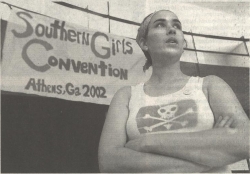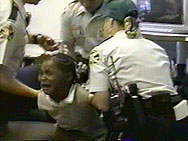So, it turns out that today is–by edict of WIPO—World Intellectual Property Day 2005. Among the objectives set out for the day are:
- To increase understanding of how protecting IP rights helps to foster creativity and innovation;
- To raise awareness of the importance in daily life of patents, copyright, trademarks and designs.
Well, who could disagree with such educational goals? The Ministries of Culture
and Science in this secessionist republic of one applaud the educational
purposes of World Intellectual Property day, and offer the following in the
effort to raise awareness of the importance in daily life of patents and
copyrights, and to make sure that you understand exactly how protecting
IP
restrictions is fostering creativity and innovation.
Intellectual property
restrictions are government-granted monopolies.
They have nothing, actually, to do with property rights; what they do is seize
ordinary people’s property and hold it hostage to the license-holders’ demands
for ransom. They kill innovation because they kill new products; they kill
new products because they invade other people’s real property — meaning pens,
paper, scanners, computers, DVD players, and so on — in the attempt to lock
down ideas — which are, by nature, non-rivalrous resources; this amounts to
nothing less than a systematic and ruthless intellectual enclosure
movement against what is and ought to be the common property of all
humanity.
Now, as a techno-geek, I don’t like how this strangles the amazing innovation
that we could be seeing in the intelligent use of audio, video, and text
content, in this age of cheap computers and plentiful storage. But the plain
fact is that this isn’t, really, about what your latest gizmo can or can’t do
with your music library, and it’s not a topic for polite debate and economic
wonkery. This is life and death. For example, in India recently:
India, a major source of inexpensive AIDS drugs, passed a new
patent law yesterday that groups providing drugs to the world’s
poorest patients fear will choke off their supply of new
treatments.
The new law, amending India’s 1970 Patent Act, affects everything
from electronics to software to medicines, and has been
expected for years as a condition for India to join the World Trade
Organization.
But because millions of poor people in India and elsewhere —
including by some estimates half the AIDS patients in the
Third World — rely on India’s generic drug industry,
lobbyists for multinational drug companies as well as activists
fighting for cheap drugs had descended on New Delhi to try to
influence the outcome.
It’s very disappointing, but it could have been worse,
said
Daniel Berman, a coordinator of the global access campaign for the
medical charity Doctors Without Borders. All generics could have
been removed from the market.
Instead, all the generic drugs already approved in India can still
be sold, though sellers must now pay licensing fees. There are also
provisions allowing companies that make generics to copy drugs in
the future.
But there are relatively tough criteria for such copying, and
activists predicted that prices for newly invented drugs will be
much higher, because drug makers will have the same 20-year patent
monopolies as they have in the West. As AIDS patients develop
resistance to old drugs, new treatments will become less
affordable, they said.
In addition, it is unclear whether makers of generic drugs in other
countries, like Brazil, China and Thailand, will fill any
increasing demand for cheaper medicines.
…
All Western countries grant product patents
on new
inventions. Since 1970, India has granted process patents,
which allow another inventor to patent the same product as long as
it was created by a novel process. In pharmaceuticals, that has
meant that a tiny tweak in the synthesis of a molecule yields a new
patent. Several companies can produce the same drug, creating
competition that drives down prices.
Before 1970, India’s patent laws came from its colonial days, and
it had some of the world’s highest drug prices. Process patents on
drugs, fertilizers and pesticides have extended life expectancy and
ended regular famines.
In Africa, exports by Indian companies, especially Cipla and
Ranbaxy Laboratories, helped drive the annual price of
antiretroviral treatment down from $15,000 per patient a decade ago
to about $200 now. They also simplified therapy by putting three
AIDS drugs in one pill. Dr. Yusuf Hamied, Cipla’s chairman, called
the new law a very sad day for India.
— New York Times 2005-03-24: India Alters Law on Drug Patents
And the same folks want to do the same thing to Latin America,
through the adoption of CAFTA:
Found to be HIV-positive shortly before her husband died of
AIDS-related complications last fall, an ailing Garcia was
convinced of her own death sentence. But generic drugs have kept
the virus in check and restored 60 lost pounds to her frame.
I now have hope,
said the 52-year-old grandmother and flower
vendor, who gets her medicine free from a nonprofit clinic.
Public health experts fear that hope might fade for Garcia and
thousands of the region’s chronically ill if the Dominican
Republic-Central American Free Trade Agreement, known as CAFTA, is
approved this year.
Under the pact American pharmaceutical giants would gain a
five-year edge on the development of new drugs by low-cost
competitors. Generic versions of name-brand drugs are the main
weapon for battling the AIDS pandemic in the developing world.
Healthcare activists say those intellectual property protections
would drive up the cost of treating chronic conditions,
particularly HIV/AIDS, sufferers of which routinely develop
resistance to old medications. About 40 million people worldwide
are infected with HIV, the virus that causes AIDS, and more than
275,000 of them live in the six Latin American CAFTA nations,
according to United Nations statistics.
— LA Times 2005-04-22: AIDS Patients See Life, Death Issues in Trade Pact
Patents kill people. They mean that the pharmaceutical cartel
can call up the armed bully-boys of almost every government in the world in
order to enforce artificially high prices for their top money-makers; and that
means that State violence is being used to prevent affordable, life-saving
drugs from reaching the desparately poor of the world. The multilateral
so-called free trade
agreements of the past couple decades — NAFTA, the
WTO, and upcoming plans such as CAFTA and the FTAA — are slowly cutting back on
traditional industrial protectionism while dramatically expanding the scale,
scope, and deadly reach of intellectual protectionism.
To hell with that. Intellectual property
is not about
incentivizing
or encouraging
or opportunities
. It’s about
force: invading other people’s property to force them to render long-term
rents to you long after you have stopped putting any particular work into what
you’re claiming to be yours. A necessary corollary is that it also means
invading those who offer innovations based on the work that you have done unless
those innovations comply with a very narrow set of guidelines for
authorized
use. You have no right to do that, and you sure don’t
have the right to do it at the expense of innocent people’s lives. A free
society needs a free culture. Patents kill and freedom save people’s lives.
This is as simple as it gets. Écrassez l’inf?@c3;a2;me: écrassez
l’etat.
Further reading
 The
The 
 We already knew that
We already knew that  A lawyer has threatened to sue police officers who handcuffed an
allegedly uncontrollable five-year-old after she acted up at a
Florida kindergarten.
A lawyer has threatened to sue police officers who handcuffed an
allegedly uncontrollable five-year-old after she acted up at a
Florida kindergarten.